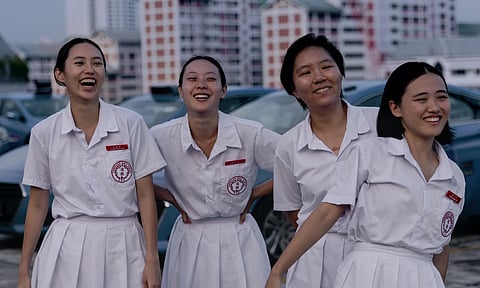

Coming of age can often become a reductive umbrella term, bypassing the many layers and nuances of transitioning to adulthood for platitudinous narratives. However, Los Angeles-based filmmaker of Singaporean origin Siyou Tan’s debut feature film, Amoeba, does the opposite, building on and broadening the ambit of the rite of passage cinema. It is a refreshingly astute and insightful exploration of a teenage girl’s inner transformation and personal assertiveness within the confines of a distinct and defined national and socio-cultural context. It’s about breaking free from a controlled environment to find one's identity, world view and place in life.
After the world premiere in Toronto and successful screenings in Busan the English and Mandarin Chinese language Singapore-Netherlands-France-Spain-South Korea co-production has been travelling the global festival circuit and caught the viewers’ attention at the recent Pingyao International Film Festival bagging the Best Actress, Youth Jury and Cinephilia Critics’ awards.
The film is about Singaporean teenager Choo Xin Yu (Ranice Tay) trying to film a ghost in her room who has been troubling her persistently. There are other troubles in life, especially at school. She studies in the upper class, Chinese, Confucian Girls’ Secondary School. Such is the level of regimentation there that the length of the skirts of the students are measured to ensure they don’t defy the dictated, modest limits. Hair has to be above the collar and no bra strap should show. Moral uprightness and diligence are desired qualities. In such a regulated environment and highly competitive education system Choo Xin Yu finds it tough to fit in, belong and thrive. She doesn’t want to be the class monitor, a position thrust on her, and which she thinks is akin to being the teachers’ servant.
In the middle of this chaos she befriends three other kindred rebellious spirits Vanessa Ooi, Sofia Tay and Gina Wong (Nicole Lee Wen, Shi-An Lim, Genevieve Tan respectively) who feel equally smothered by the many rules in the school, the autocratic ways of the teachers, not to forget the corporal punishment.
They hang out in a construction site, dig out and discover relics. What also brings them together is the shared interest in the triad gangs who are supposed to have ruled the streets of Singapore during colonial times. They inspire them to form a gang of their own as an act of resistance. But how will the brash, devil may care attitude and reckless, rowdy ways of the gang be tolerated in Singapore, a country that is stickler for rules and regulations and where chewing gum (and now vapes), eating and drinking and even carrying durians in public transport is prohibited. Jack Kao plays Uncle Phoon, Sofia’s chauffeur who is the wind beneath their wings. He is their only confidant, the one who stokes the creative resistance. As they go about showing their middle finger to the world, things come to a head when the camcorder recordings of their gang activities get discovered by their teacher and expulsion looms large.
The unruly, erratic, fits-and-spurts narrative reflects the disorderliness and capriciousness of the girls’ lives. Much of the film’s strength derives from Ranice Tay’s performance who is to the camera born. She is mesmerising as the adolescent Choo Xin Yu, at times uncertain and skittish but largely confident, spunky and intrepid in dealing with life’s many challenges and conflicts, including becoming aware of her unrealized queerness. Tay brings her alive on screen with an enviable ease, abandon and spontaneity. Her camaraderie and bonding with the three girls is real and earthy and very relatable.
Siyou Tan is sympathetic in dealing with the dilemmas of the young women. The found footage feel of horror films, the camcorder imagery and intimate, observant yet non-intrusive camera of Neus Ollé along with the measured editing of Félix Rehm help Tan in building the young subculture effectively, with a unique sense of rhythm of its own. Tan is equally adept in using the young feminine angst as a metaphor to dwell on a nation in ferment and the thin line that separates discipline and efficiency from control and conformism.
Tan also plays dexterously with the idea of the history and myth-making and memories and inheritances with Singapore’s mascot Merlion as the dominant metaphor. The stories that are transmitted across generations as opposed to the supposed truisms that we are made to accept unquestioningly. Most so, how the shared past has a bearing on our collective present and the future and needs to be retrieved and reclaimed to find our own individual liberation.